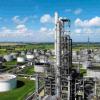|
|
Cryogenic Separation Of Steam Reforming Syngas
#1

Posted 15 May 2023 - 07:57 AM
#2

Posted 15 May 2023 - 08:32 AM
More description would help. Is your composition on mass basis or mole basis? Where did the oxygen come from? Is this supposed to mimic some commercial process?
#3

Posted 15 May 2023 - 10:15 AM
It is my first time to see syngas with both high concentration of H2 and O2. why the O2 concentration is so high?
#4

Posted 15 May 2023 - 01:37 PM
See if the SEP unit op in AspenPlus will be good enough for your CO2 separation. You give the unit spec on how much CO2 remains and set the temperature and pressure of the vapor outlet. You should know the answer you want out of the amine absorber and the SEP unit can give you that answer without trying to converge a distillation column. You will then need to add water to the model to saturate the vapor which leaves the amine solution so you may need to add a dryer to your process. Cryogenic distillation is not recommended for your process. Maybe a membrane unit would be better for separating the hydrogen. The oxygen/nitrogen product has little value so vent that stream without further separation. Model the amine system for sizing after your initial material balance is complete. [And do confirm you really have oxygen in the feed and get rid of it before further processing.]
#5

Posted 15 May 2023 - 04:02 PM
Start at the beginning. From what process does this syngas originate?
Bobby
#6

Posted 16 May 2023 - 07:21 PM
Oxygen is degraded MDEA.
#7

Posted 17 May 2023 - 04:39 AM
More description would help. Is your composition on mass basis or mole basis? Where did the oxygen come from? Is this supposed to mimic some commercial process?
the Composition is mass based. its based on Partial oxidation of methane. its for a school project that involves design of a Urea plant using the Snamprogetti process .With Hydrogen coming from steam reforming Methane
#8

Posted 17 May 2023 - 04:52 AM
It is my first time to see syngas with both high concentration of H2 and O2. why the O2 concentration is so high?
the purpose of the reforming was to make hydrogen for ammonia synthesis that is why the concentration is high and the O2 concentration is high due to the fact that balances were done for partial oxidation steam reforming so excess air was added as well to provide N2 as a source of N2 as well in the process
#9

Posted 17 May 2023 - 05:12 AM
It is my first time to see syngas with both high concentration of H2 and O2. why the O2 concentration is so high?
the purpose of the reforming was to make hydrogen for ammonia synthesis that is why the concentration is high and the O2 concentration is high due to the fact that balances were done for partial oxidation steam reforming so excess air was added as well to provide N2 as a source of N2 as well in the process
It seems counterintuitive to have partial oxidation and an excess of O2?
#10

Posted 17 May 2023 - 05:27 AM
Air is usually added in such a process immediately after the steam reformer at a high temperature over catalyst where the oxygen reacts to completion. You should be able to find online descriptions and material balances for the ammonia process.
#11

Posted 17 May 2023 - 08:57 AM
See if the SEP unit op in AspenPlus will be good enough for your CO2 separation. You give the unit spec on how much CO2 remains and set the temperature and pressure of the vapor outlet. You should know the answer you want out of the amine absorber and the SEP unit can give you that answer without trying to converge a distillation column. You will then need to add water to the model to saturate the vapor which leaves the amine solution so you may need to add a dryer to your process. Cryogenic distillation is not recommended for your process. Maybe a membrane unit would be better for separating the hydrogen. The oxygen/nitrogen product has little value so vent that stream without further separation. Model the amine system for sizing after your initial material balance is complete. [And do confirm you really have oxygen in the feed and get rid of it before further processing.]
hmm thank you that is quite an eye opener i think an absorber works for the CO2 and would it be advisable to say use of a palladium absorber rto remove the hydrogen from the stream. the main issue here being that the nitrogen i had stated in my problem statement to my supervisor that the nitrogen will be sent to the ammonia plant this is for a design problem for school for production of urea fertiliser with methane reforming providing the hydrogen.
#12

Posted 17 May 2023 - 12:51 PM
There is no reason to separate the H2 from the N2 since they will be reactants in the same reactor. Just get the proportions of nitrogen and hydrogen correct and send the stream to the reactor loop after removing the other components. There should be no elemental oxygen as it will all be reacted to CO or CO2 or H2O. Convert the CO to CO2 then remove the CO2 with an amine system. Convert any remaining CO and CO2 to CH4. For student work, an aqueous MEA system will be easiest to model for CO2 removal. Here is a diagram showing the main reaction units for the ammonia process: https://image.slides...eets-2-2048.jpg There is plenty of references inside the internet on the ammonia process. Snam urea process has flowsheets also. You can try to reinvent these processes but you will likely run into dead ends. The Haber-Bosch ammonia process is over 100 years old and quite reliable.
#13

Posted 22 May 2023 - 02:27 PM
What is your flow rate? Typically for separation of gases, there are smaller use cases with pressure swing adsorbers (PSA) that utilize an adsorbent and then there are the cryogenic separation units for higher flow rates, when the PSA units can't keep-up.
This should be a first consideration unless your required to use the cryogenic unit operation.
Similar Topics
Steam Pots Cyclic Pressure Pulsation And Water HammeringStarted by Guest_Abdelilah_* , 07 Dec 2025 |
|

|
||
Steam Drum SizingStarted by Guest_nastaran_* , 01 Dec 2025 |
|

|
||
Acidic Condensate In Sulphate Recovery By Vapour SeparationStarted by Guest_Ranga v_* , 09 Nov 2025 |
|

|
||
Seeking Feedback On My Process Flow Diagram. Biogas Steam Reforming ToStarted by Guest_Jacobaum_* , 27 Oct 2025 |
|

|
||
Design Of Direct Contact After Cooler (Dcac) For Air Separation UnitStarted by Guest_Paulogeorge_* , 29 Jul 2025 |
|

|

 FB
FB










